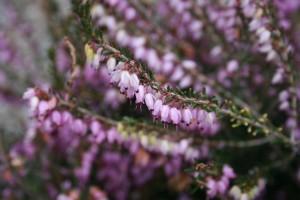 |
| Heather Plant Propagation |
I’ve begun my first plant propagation experiment this year with heather. Heaths and heathers grow very well here in my zone 7 garden. I think they must like the acidic soil. Perhaps it reminds them of home somewhere in Scotland? The heather plants that I added to my garden several years ago are now huge, the size of small shrubs. They bloom profusely as soon as the first warm weather breaks in January. Even though they get snowed on, frozen again, and generally beaten up by Mother Nature, they just keep blooming until the weather warms up. In the middle of winter, when nothing else even seems alive in the garden, the site of those purple or white bell-shaped flowers brings me great joy. It also nurtures the bees who may awaken from their wintertime slumber. We do occasionally see pollinating insects awake during the winter, too, and I can’t help but thank the heather in my heart for providing a little sustenance to the hungry insects.
This year, my husband noticed what he thought were seeds hanging from the spent heather blossoms. Ever the scientist at heart, he collected the seeds into a plastic bag and saved them for me. I cleaned off my plant shelves this past weekend and planted tomatoes and peppers. I also decided to try a plant propagation experiment with heather.
All of my gardening books and the websites that I found talked about propagating heather through cuttings. I couldn’t find anything about starting heather from seeds! So I decided to run a science experiment. I found two pots of equal size and filled both with the exact same sterile soil mixture purchased from the garden center. Next, I placed the heather seeds in one pot. In the second pot, I placed woody stems snipped from the heather plants and dipped in rooting hormone. I covered this pot with a plastic bag, watered both pots, and placed them right next to each other on the same shelf of my plant lights. I labeled both with the date when planted. Now we wait.
My experiment is to see which heather plants grow, and if I get an equal results from both pots, which ones flourish the best outside in the garden. We have several new garden areas to plant this year and I would like nothing better than to add more heathers. I’ll let you know how my little science experiment with plant propagation works out!




